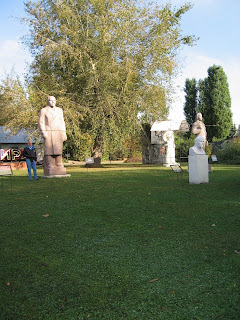 |
| San Antonio Express-News, 7/21/2020: p. 3 |
This past Tuesday, National Public Radio's Morning Edition had a short segment on what I've always known as the "Park of Fallen Idols." I visited it in 2000, and of all the memories I have of a study conference in Moscow and Saint Petersburg that year, this is the one I remember best. SInce I've seen it, it has been expanded and now comprises part of the Muzeon complex, that also includes the Tretyakov Museum of Modern Art, a sculpture
 |
| Lenins in the Park, Muzeon Complex, Moscow |
 |
| The offending statues cited in the headline above |
At this very moment, we in the U.S. are in the process of toppling our own monuments to now literally fallen heroes, now images of Confederate soldiers, most standing, a few on horseback. Though they were memorials to the losers, we still see them as uncomfortable reminders of a horrific part of our history. The same can be said for sculpted monuments to Columbus, who as well know now, didn't "discover" America--even as a European; he only represents the advent of European colonialism. The Vikings before him and probably also European cod fishermen had already been there, but only came to get a few goods or hang out for awhile.
Tearing down monuments to disgraced former ideas or leaders has been around as long as humans have been making them. Just think of the obliteration of Pharoah Akhenaten's whole city of Akhetahten (Amarna) by his successors, or the legend of the Golden Calf--a
 |
| Nicolas Poussin: The Golden Calf, London, National Gallery |
On the other hand, sometimes they have multiple evocations as in the instance of the Vendome Column, a colossal self-glorification of Napoleon in the form of a big Roman-style triumphal column like Trajan's that the Emperor of the French had made to commemorate the Victory of Austerlitz in 1805. It was (and is) located in the place de la Vendome, on the site of an earlier equestrian statue of Louis XIV, destroyed during the French Revolution. Like the Roman one, the column was very tall (at 44 meters, or around 145 feet, or taller than its Roman prototype by around 15 feet) with a spiral of imagery narrating Napoleon's victory, cast from captured cannons from the Austerlitz battle, and topped by a bronze image of Napoleon as a reincarnation of a Roman emperor. After Napoleon fell, the top effigy was replaced by several different flags, depending on who was in power, later by an image of Napoleon again in his more positive role as "the Little Corporal," and then, under his nephew, Napoleon III by a replica of the original Roman-style image again.
 |
| Fallen Napoleon: The Vendome Column 1871 |
By 1871, after the Franco-Prussian war and Napoleon III's downfall, the revolutionary Communards who briefly held power had had enough. They pulled the whole thing down, and therein lies the tale of the painter Courbet's populist role in the demolition, for which he was briefly imprisoned, presented with the bill for the column's restoration, and caused him to self-exile to Switzerland. It was re-erected shortly afterwards in 1873 by the Third
Republic with Napoleon-as-Roman Emperor on it once again and has stood unopposed in its luxurious plaza ever since. Nobody has seen fit to criticize it much since then, except for the architect/architecural historian Daniel Gissen's proposal to make a dirt-mound installation to temporarily cover the columns base in 2013-14 in order to commemorate the temporary demolition of 1871.
So, once those Civil War soldiers and Columbus are all taken down, what will we do with them? Many of them were previously in parks; do we collect them all like the Russians did? I bet that if we had all of the statues and monuments of former gods and heroes in one place, they'd occupy more space than Arlington National Cemetery does. When they were in situ, how many of us actually looked at them anyway? Why do visible symbols have such power? But that's not the real point: why must we continue to make these graven images at all? Are humans hard-wired to fashion visible idols?
__________________________________________________________________
The article in the Express-News covers the proposed monument demolition in Austin; many local newspapers in the U.S. have similar articles on other local examples. For another reference to the removal of a statue of Columbus from San Antonio, see:https://www.ksat.com/news/local/2020/07/01/crews-remove-christopher-columbus-statue-to-fix-vandalism/
For a recent discussion of the Muzeon Fallen Heroes Park on NPR: https://www.npr.org/2020/07/21/892914684/what-to-do-with-toppled-statues-russia-has-a-fallen-monument-park
For a nice overall discussion of the Bamiyan Buddhas: https://www.khanacademy.org/humanities/ap-art-history/west-and-central-asia-apahh/central-asia/a/bamiyan-buddhas
The most interesting succinct discussion of the Vendome Column can be found in the French Wikipedia article :https://fr.wikipedia.org/wiki/Colonne_Vendôme#/media/Fichier:Colonne_vendome.jpg
David Gissen's proposal to cover the Vendome Column's base with an earthwork can be explored at: https://www.cca.qc.ca/en/events/3430/the-mound-of-vendome
